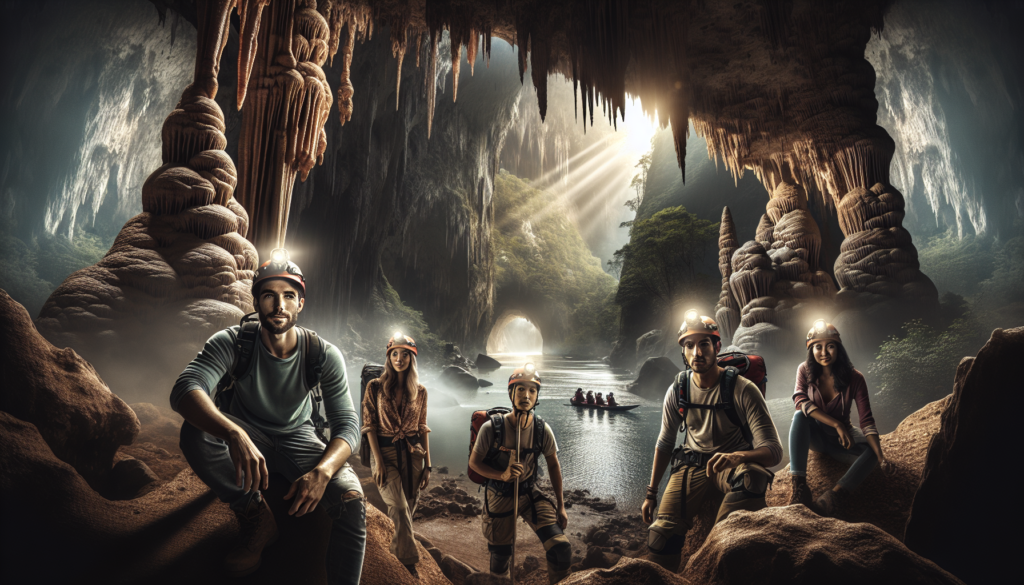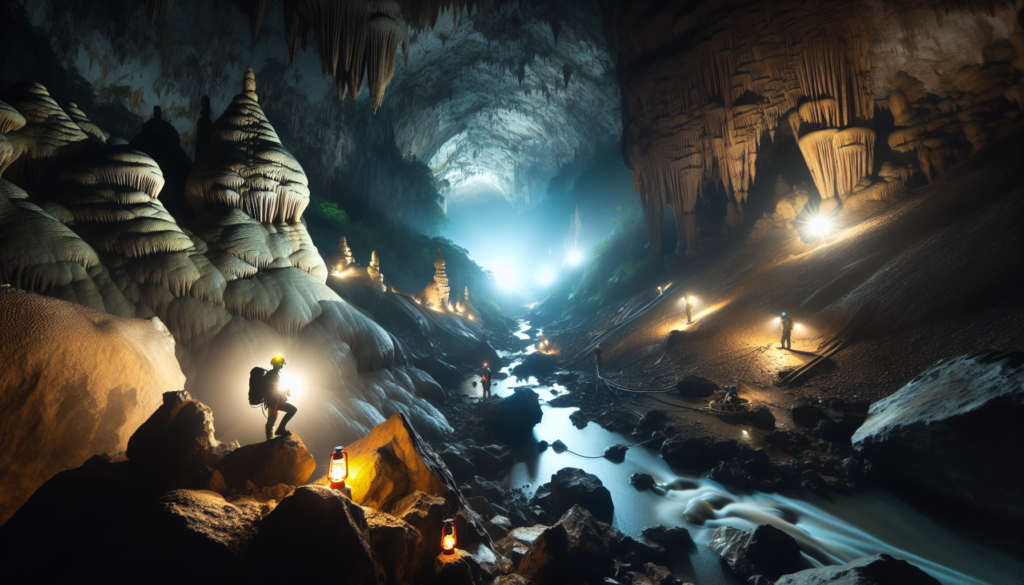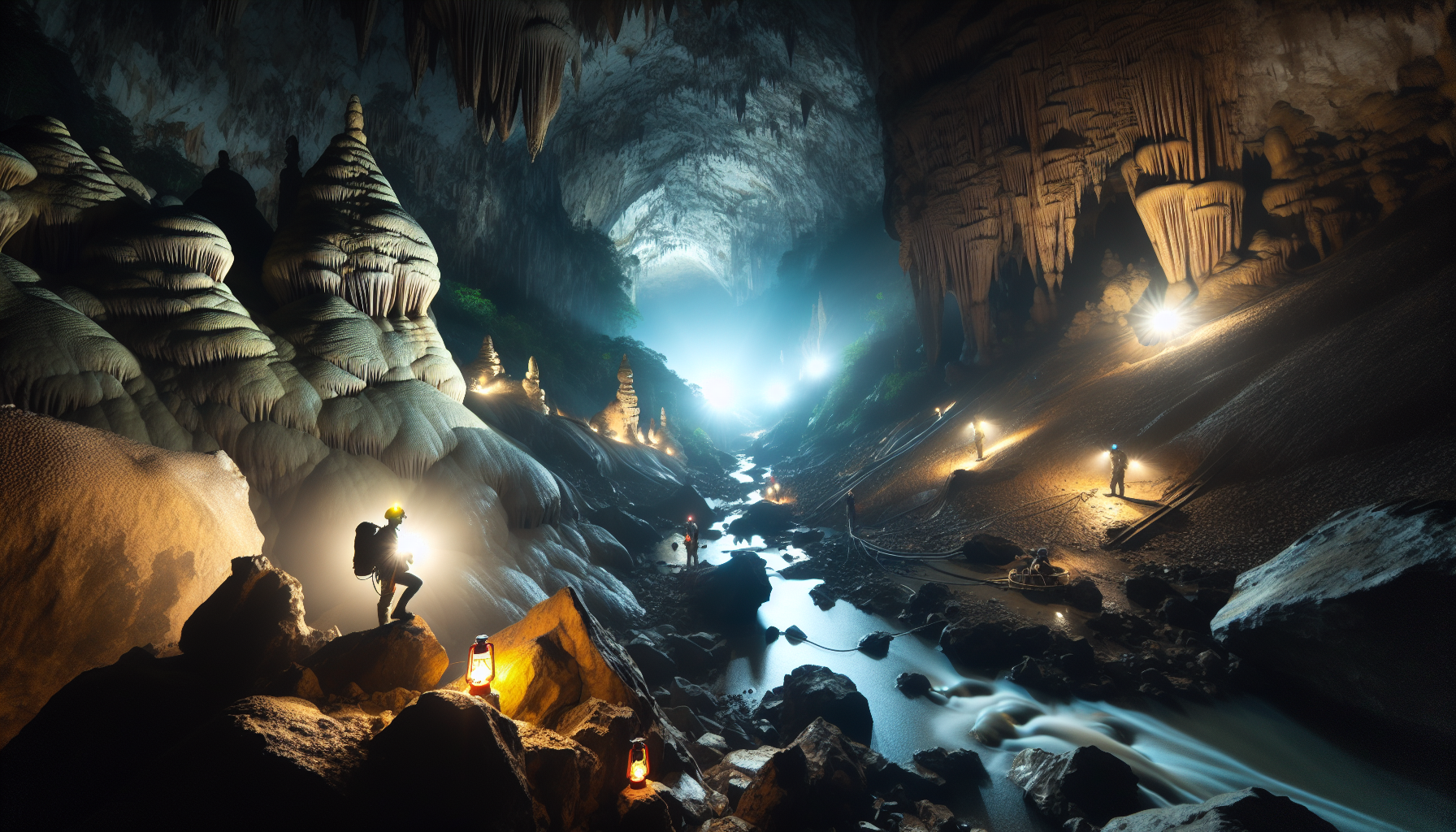Imagine embarking on a thrilling journey deep into the Earth’s mysterious depths, uncovering hidden wonders and discovering ancient secrets. In this captivating article, we delve into the world of adventure travel and explore the exhilarating experience of cave exploration. From the breathtaking stalactites of Hang Son Doong in Vietnam to the awe-inspiring ice formations of Eisriesenwelt Cave in Austria, join us as we embark on a mesmerizing adventure, where every twist and turn reveals a sight that will leave you in awe. So grab your headlamp and prepare to be amazed as we take you on a thrilling expedition into the fascinating world of cave exploration.

Different Types of Caves
Solution Caves
Solution caves, also known as karst caves, are the most common type of caves found around the world. These caves are formed by the dissolution of soluble rocks such as limestone, dolomite, and gypsum. The process of water slowly dissolving the rock over thousands of years creates intricate networks of tunnels and chambers. One famous example of a solution cave is Mammoth Cave in the United States, which is the longest known cave system in the world.
Sea Caves
Sea caves are formed by the relentless power of the ocean waves crashing against the coastline. Over time, the repetitive force of the waves erodes the soft rock, creating hollowed-out caves. Sea caves are often found in cliffs or rocky coastlines and can only be accessed by boat or swimming. Waitomo Caves in New Zealand is known for its spectacular glowworms that illuminate the dark cave walls, creating a magical and otherworldly experience.
Lava Tubes
Lava tubes are unique cave formations that are created by flowing lava during volcanic eruptions. When the outer layer of lava cools and hardens, the molten lava beneath continues to flow, leaving a hollow tube behind. These caves can stretch for miles and provide a fascinating glimpse into the volcanic activity of the past. One well-known lava tube is the Thrihnukagigur volcano in Iceland, which offers visitors the opportunity to descend into the dormant volcano and explore its colorful underground chambers.
Ice Caves
Ice caves, as the name suggests, are caves that are formed within glaciers or ice sheets. These caves are created by the melting and refreezing of ice, causing intricate passageways to form within the frozen mass. Ice caves can be found in cold regions such as Alaska, Switzerland, and Iceland, where the frozen landscapes provide a stunning backdrop for exploration. The Vatnajökull Ice Cave in Iceland is renowned for its crystal-clear ice formations and vibrant blue colors.
Glacier Caves
Glacier caves are similar to ice caves but are formed within glaciers themselves. These caves are often temporary structures, as they can collapse or melt as the glacier moves and changes shape. Glacier caves offer a unique opportunity to witness the ever-changing nature of these majestic ice formations. The caves of the Apuseni Mountains in Romania are known for their beautiful ice formations and are a popular destination for adventurous explorers.
Most Popular Caving Destinations
Mammoth Cave National Park, USA
Mammoth Cave National Park in Kentucky, USA, is a must-visit destination for caving enthusiasts. With over 400 miles of explored passageways, it is the longest known cave system in the world. Visitors can take guided tours to explore a variety of unique formations and learn about the rich history of the caves. The park offers a range of tours suitable for different fitness levels and interests, making it an ideal destination for both experienced cavers and beginners.
Waitomo Caves, New Zealand
Located on the North Island of New Zealand, the Waitomo Caves are famous for their luminescent glowworms. Visitors to these caves can witness the magical sight of thousands of tiny glowworms illuminating the dark cave walls, creating a surreal and enchanting atmosphere. In addition to glowworm tours, Waitomo also offers more adventurous activities such as blackwater rafting, where visitors can float through the cave system on inner tubes, guided only by the glowworms’ light.
Caves of Aggtelek Karst and Slovak Karst, Hungary and Slovakia
The Caves of Aggtelek Karst and Slovak Karst form an expansive cave system that spans the border between Hungary and Slovakia. This UNESCO World Heritage Site offers a unique opportunity to explore interconnected caves, some of which are adorned with stunning stalactites and stalagmites. Guided tours are available to showcase the diverse range of cave formations and educate visitors about the geological significance of the area.
Caves of the Apuseni Mountains, Romania
The Apuseni Mountains in Romania are home to a network of breathtaking caves that are waiting to be explored. These caves offer visitors the chance to witness stunning ice formations in winter and marvel at the complex geological structures year-round. The Scarisoara Ice Cave is one of the highlights, featuring a massive underground ice block that can be admired from a specially built walkway.
Phong Nha-Ke Bang National Park, Vietnam
Phong Nha-Ke Bang National Park in Vietnam is a hidden gem for caving enthusiasts. With over 300 caves and grottoes, including the world’s largest cave, Son Doong Cave, this park offers unparalleled opportunities for exploration. Son Doong Cave is a once-in-a-lifetime adventure, where visitors can trek through massive underground chambers and witness incredible natural formations that are millions of years old.
Safety and Precautions
Cave Diving Certification
Cave diving is a specialized form of diving that requires additional training and certification. Before attempting cave diving, it is crucial to undergo a cave diving course to learn the necessary skills and safety procedures. This certification ensures that divers are adequately prepared to navigate the unique challenges and potential hazards of cave diving, such as limited visibility and restricted access.
Informed Guides
When exploring caves, it is essential to have a knowledgeable and experienced guide who can lead you through the cave system safely. These guides are familiar with the caves’ layout, potential risks, and can offer valuable insights and information about the cave’s history and geology. Always book tours with reputable and licensed guides or tour operators who prioritize safety and environmental conservation.
Proper Equipment
Having the right equipment is crucial for a safe and enjoyable caving experience. A well-fitting helmet is essential to protect your head from potential bumps and falling rocks. A reliable headlamp is necessary to navigate through the dark caves, providing ample illumination. A caving suit, made from durable and water-resistant materials, will protect your clothing from abrasions, water, and mud. Sturdy boots with good grip and ankle support are vital for walking on uneven surfaces. Finally, gloves will protect your hands from sharp rocks and rough surfaces.
Physical Fitness
Caving can be physically demanding, requiring a certain level of fitness and mobility. Before embarking on a cave exploration, it is advisable to assess your physical condition and prepare accordingly. Regular exercise, such as hiking or swimming, can help improve endurance and strength. Additionally, practicing crawling or climbing exercises can help familiarize your body with the movements required in cave exploration.
Emergency Planning
When venturing into caves, it is essential to have a comprehensive emergency plan in place. Inform someone trustworthy about your itinerary, including the cave you plan to explore, the duration of your trip, and a time frame for your return. Carry essential safety items such as a first aid kit, a whistle for signaling for help, and extra food and water in case of unexpected delays. Familiarize yourself with the emergency exit routes and locations of emergency equipment within the cave. By being prepared, you can ensure a safer and more enjoyable caving experience.
Equipment Required for Cave Exploration
Helmet
A sturdy and well-fitting helmet is a crucial piece of equipment for cave exploration. It protects your head from potential falling rocks, low ceilings, and other hazards that may be present in the cave environment.
Headlamp
A reliable headlamp is essential for navigating through the dark and often challenging terrain of caves. It provides hands-free illumination, allowing you to see your surroundings and safely maneuver through passageways.
Caving Suit
A caving suit is designed to protect your clothing from abrasion, water, and mud. It is typically made from durable and water-resistant materials, ensuring that you stay dry and comfortable during your cave exploration.
Boots
Sturdy boots with good grip and ankle support are vital for cave exploration. They provide stability and protection for your feet, especially when walking on uneven surfaces, slippery rocks, or in wet conditions.
Gloves
Gloves are necessary to protect your hands from sharp rocks, rough surfaces, and potential injuries. They provide an additional layer of defense against abrasions and cuts, ensuring a safer and more comfortable caving experience.
By having the right equipment, you can ensure your safety and enhance your overall enjoyment while exploring caves.

Adventures in the Dark
Challenging Terrain
Caving often involves navigating through challenging terrain, such as tight passageways, steep inclines, and uneven surfaces. The thrill of overcoming these obstacles adds an element of adventure to the exploration. Be prepared for crawling, climbing, and potentially squeezing through narrow gaps, as you uncover the hidden wonders of the underground world.
Squeezing through Tight Passages
One of the unique aspects of cave exploration is squeezing through tight passages that may only allow for a single person to pass at a time. These passages, known as squeezes or crawlways, can be physically demanding and require flexibility and maneuverability. Overcoming these challenges can be exhilarating and provide a sense of accomplishment.
Rappelling into Abysses
Some caves feature vertical drops or abysses that require rappelling techniques to descend safely. Rappelling involves using specialized equipment, such as ropes, harnesses, and descenders, to control your descent down vertical surfaces. The adrenaline rush of rappelling into the depths of a cave adds an extra element of excitement to the adventure.
Navigating Underground Rivers
Many caves feature underground rivers or streams that need to be crossed or navigated. These waterways can present their own set of challenges, requiring careful navigation and sometimes even swimming. Exploring the dark caves while wading through underground rivers adds a sense of mystery and exploration to the experience.
Discovering Hidden Chambers
Hidden chambers within caves are often filled with awe-inspiring formations and breathtaking beauty. Getting a glimpse of previously unseen chambers is like stepping into a world untouched by the outside. These hidden gems can leave a lasting impression and make the entire caving adventure worthwhile.
The Thrill of Cave Diving
Exploring Underwater Caves
Cave diving takes the adventure of caving to a whole new level by exploring underwater cave systems. Equipped with scuba gear, divers can explore stunning underwater chambers, tunnels, and passages. The crystal-clear waters and pristine formations found in underwater caves offer a unique and mesmerizing experience.
Understanding Cave Diving Techniques
Cave diving requires specific techniques and skills to ensure safety and successful exploration. Divers must be proficient in buoyancy control, navigating in low visibility conditions, and handling potential hazards such as entanglement and silt-out. Proper training and practice are essential before attempting cave diving to understand the intricacies involved in this thrilling activity.
Risks and Safety Measures
Cave diving carries inherent risks, including limited visibility, entanglement hazards, and potential equipment failures. It is crucial to take necessary safety precautions and follow established protocols to mitigate these risks. Cave divers should always dive with a buddy, use adequate lighting and safety equipment, and have a thorough understanding of emergency procedures.
Training and Certifications
Before attempting cave diving, divers must undergo specialized training and obtain the appropriate certifications. These courses teach divers the skills, knowledge, and safety protocols necessary for cave diving. Training typically includes theoretical lessons, pool training, and open water dives under the guidance of experienced cave diving instructors.
Famous Cave Diving Sites
There are several renowned cave diving sites around the world that attract experienced divers seeking adrenaline-pumping underwater adventures. The Blue Hole in Belize, the Cenotes in Mexico’s Yucatan Peninsula, and the Ginnie Springs in Florida, USA, are just a few examples of popular cave diving destinations. These sites offer divers the opportunity to explore unique underwater cave systems filled with stunning rock formations and diverse marine life.
Unique Cave Formations
Stalactites and Stalagmites
Stalactites and stalagmites are common cave formations that are formed by the slow deposition of mineral-rich water. Stalactites hang from the cave ceiling, while stalagmites grow upward from the cave floor. These formations create stunning displays of natural beauty, with intricate structures often resembling icicles or pillars.
Cave Pearls
Cave pearls are spherical formations made from the accumulation of minerals in water droplets. Over time, these minerals build up around a nucleus, such as a grain of sand, creating a pearl-like structure. Cave pearls can be found in caves with water flow, and their smooth, polished appearance adds a touch of elegance to cave formations.
Columns and Curtains
Columns and curtains are formed when stalactites and stalagmites merge together over time, creating a solid structure that connects the cave floor and ceiling. These formations can vary in size and shape, ranging from thin and delicate curtains to massive columns that seem to defy gravity. Columns and curtains add an element of grandeur to cave interiors and showcase the geological processes that shape our planet.
Flowstones
Flowstones are created by the slow flow of water over cave surfaces, depositing minerals and forming smooth, undulating layers. These formations can resemble frozen waterfalls or cascades and add a sense of movement and grace to cave interiors. Flowstones can be found in a variety of colors, depending on the minerals present in the water.
Helictites
Helictites are unique formations that defy gravity and grow in unconventional and often twisted shapes. Unlike stalactites and stalagmites, helictites appear to have a mind of their own, growing in seemingly random directions. These delicate formations are formed by the slow seepage of mineral-rich water and are a testament to the diverse and fascinating world of cave formations.
The Rich History of Cave Exploration
Early Cave Dwellers and Paintings
Caves have served as shelters for humans since ancient times. Early cave dwellers sought refuge in the natural caves, using them as protection from the elements and predatory animals. Some of these caves, such as Lascaux Cave and Chauvet Cave in France, are famous for their prehistoric cave paintings. These intricate artworks offer a glimpse into the lives and beliefs of our ancestors, and they have played a significant role in understanding early human history.
Archaeological Discoveries
Caves have often been repositories of valuable archaeological discoveries, providing glimpses into past civilizations and cultures. Archaeologists have uncovered ancient artifacts, tools, and even human remains in caves around the world. These discoveries shed light on our collective human history, providing important insights into the ways of life of those who came before us.
Cave Exploration in Modern Times
Cave exploration as a recreational activity began in the early 20th century, with adventurers and explorers seeking new frontiers underground. The exploration of caves has evolved from a scientific endeavor to a popular form of adventure tourism. Modern exploration techniques, such as advanced mapping and cave diving, have allowed humans to push the boundaries of cave exploration further than ever before.
Pioneering Cave Explorers
Throughout history, there have been pioneering individuals who have dedicated their lives to cave exploration. These explorers ventured into the unknown, often risking their lives in pursuit of knowledge and discovery. Notable cave explorers include Édouard-Alfred Martel, who is considered the father of modern speleology, and Bill Stone, a pioneer in cave diving and deep cave exploration. Their contributions have paved the way for future generations of cave explorers.
Scientific Research and Studies
Caves continue to be a valuable source of information for scientific research and studies. Geologists, biologists, hydrologists, and climatologists are just a few of the scientists who study caves to gain insights into various fields. Caves offer unique opportunities to study geological formations, the effects of climate change, and the adaptation of cave-dwelling organisms. The findings from cave research contribute to our understanding of Earth’s history and environmental processes.
Caving Etiquette and Conservation
Leave No Trace
When exploring caves, it is essential to practice the principles of Leave No Trace. This means leaving the cave environment as you found it, without leaving any trace of your visit. Avoid damaging formations, removing anything from the cave, or littering. By respecting the fragile cave ecosystems, you can ensure that future generations can also enjoy their beauty.
Respecting Wildlife
Caves are home to a variety of unique and often delicate organisms. It is important to be mindful of their presence and avoid disturbing or harming any wildlife you encounter. Flash photography and loud noises can be particularly distressing to cave-dwelling organisms. By observing wildlife from a respectful distance and minimizing your impact, you can help protect these fragile ecosystems.
Following Guidelines and Regulations
Many cave systems have specific guidelines and regulations in place to protect the caves and ensure visitor safety. These may include restrictions on cave entry, specific access routes, or limitations on group sizes. It is crucial to familiarize yourself with these guidelines beforehand and follow them diligently. By adhering to regulations, you can help preserve cave environments and contribute to a safe and sustainable caving experience.
Participating in Conservation Efforts
There are numerous organizations and initiatives dedicated to cave conservation and preservation. You can support these efforts by volunteering your time for cave clean-up activities, participating in citizen science projects, or donating to organizations that work towards cave preservation. By actively engaging in conservation efforts, you can contribute to the long-term preservation of caves and their ecosystems.
Sharing and Educating Others
One of the best ways to promote cave conservation is by sharing your experiences and educating others about the importance of preserving these unique environments. Raise awareness about responsible caving practices, the ecological value of caves, and the need for sustainable tourism. By spreading the message and inspiring others to respect and protect caves, you can make a positive impact on the conservation of these fragile ecosystems.
Preparing for a Cave Adventure
Researching and Choosing a Cave
Before embarking on a cave adventure, it is essential to research and choose the right cave for your experience level and interests. Consider factors such as cave difficulty, accessibility, guided tour options, and the specific cave formations you wish to see. Familiarize yourself with the cave’s regulations and requirements to ensure a smooth and enjoyable visit.
Checking Local Weather and Conditions
Caves can be affected by weather conditions, so it is crucial to check local weather forecasts and conditions before heading out. Heavy rains or flooding can make some caves unsafe or inaccessible. Additionally, extreme temperatures or adverse weather conditions can impact your comfort and safety during the cave exploration. Stay informed and plan your trip accordingly.
Packing Essentials and Survival Kit
When venturing into a cave, it is important to pack essential items and a survival kit to ensure your safety and well-being. Some essential items to include are a first aid kit, extra clothing and socks, food and water, a whistle, a multi-tool, a compass or GPS device, and a map or guidebook of the cave. Depending on the specific cave and its challenges, you may need additional equipment such as ropes or climbing gear.
Planning for Emergency Situations
Cave exploration comes with inherent risks, and it is crucial to plan for potential emergency situations. Inform someone trustworthy about your itinerary and expected return time. Familiarize yourself with emergency exit routes and understand the cave’s communication systems, if available. Carry emergency contact information and know how to use safety equipment such as ropes or harnesses. By preparing for emergencies, you can be better equipped to handle unexpected situations.
Informing Others about Your Itinerary
Before heading into a cave, inform a friend or family member about your itinerary. Share details such as the cave you plan to explore, the duration of your trip, and your expected return time. This information will be invaluable in case of an emergency or if you fail to return as scheduled. By keeping others informed, you ensure that help can be called upon if needed.
In conclusion, caving offers a thrilling and immersive way to explore the hidden wonders of our planet. With various types of caves, popular destinations, safety precautions, and unique formations, there is something for every adventurer. By adhering to safety guidelines, practicing conservation, and being prepared for your adventure, you can embark on an unforgettable journey into the depths of the Earth. Whether you are squeezing through narrow passageways, rappelling into abysses, or marveling at stunning formations, the world of cave exploration awaits you.

